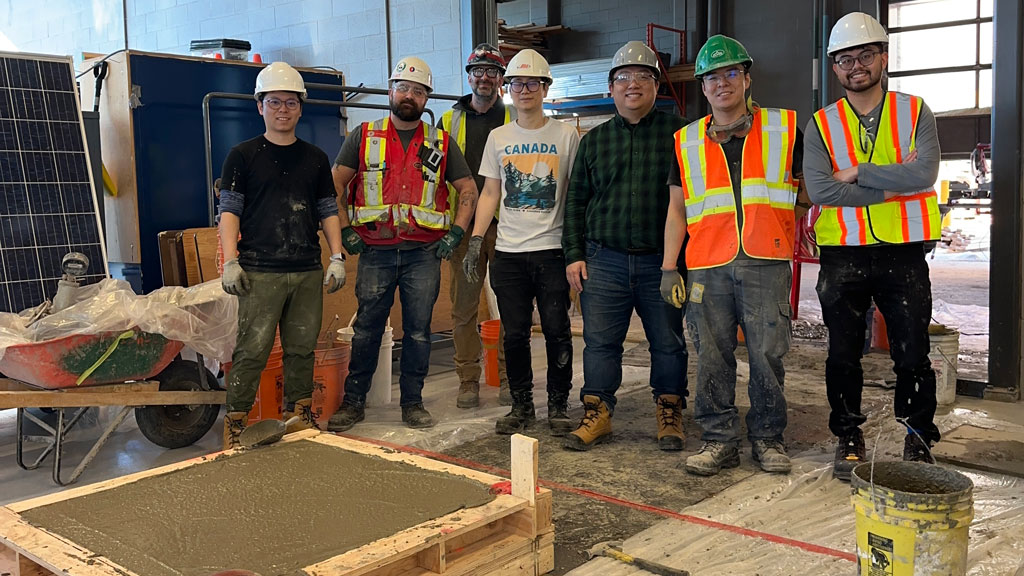A group of civil engineering technology students who worked on a research project at the Southern Alberta Institute of Technology (SAIT) in Calgary has concluded adding a certain amount of graphene to concrete can make the material more impermeable to water and increase the strength of the mix.
The students tested the concrete by pouring slabs for a sidewalk and, after conducting a number of freeze-thaw and compressive assessments, found the strength of the material was significantly increased.
The research is important because it could be used to cut down on costly repairs to sidewalks in Calgary. In 2023 alone, the city spent $8 million on sidewalk repairs.
The research confirmed graphene, in the right mix, can “increase the compressive strength in concrete applications,” project lead Derrick Leung, now a civil engineering technologist with Urban Systems Ltd. in Calgary, said in an interview. “We were able to increase the strength by about 14 per cent.”
There has been a lot of research done on how graphene can make concrete more durable and water-resistant, but the students wanted to see for themselves if it could be specifically used for sidewalks in Calgary as they are perpetually prone to cracking due to repeated freeze-thaw cycles in winter.
Initially, as part of their year-end project, the students had intended to explore how to improve asphalt pavement but landed on concrete after learning sidewalk repairs in Calgary were hefty.
An instructor at the institute alerted students to the potential of graphene and how, over the past couple of decades, there has been a lot of research done on its application in concrete.
The rest is history.

The team – which also included SAIT students Tony Ly, Pinyo Sirisettanan and Chi Kin Wong – tapped into the research and tested what happens when different amounts of graphene are added to the concrete mix.
Graphene, the same material found in daily objects like the lead of a pencil, is one of the most important elements in nature. It is a tough, flexible and light substance made of pure carbon and is 200 times more resistant than steel and five times lighter than aluminum. It is used by many industries.
Leung said an ultra-thin layer of the material – 0.25 nanometers to be exact – was embedded into the concrete.
“It’s tiny compared to conventional fibres that are added to concrete like steel,” he noted. “And in terms of flexibility, graphene is pretty high compared to steel.”
Over a period of six months, team members researched the advantages of using graphene in the concrete and tested different mixes. They poured slabs of the mix and did a number of compressive and freeze-thaw tests.
They didn’t have the equipment to research what happens at the microscopic level but found graphene did help the process of bonding elements in the concrete.
With the help of Chandos Construction, which does a lot of work at the SAIT campus, the team was able to pour a couple of slabs and test what they’d learned about the product in the lab in a real-world environment.
“We were able to get their assistance and use some of their equipment and we were able to pour two slabs and test them in the outdoor environment as compared to a lab-controlled one,” said Leung.
The conclusion?
The team proved by adding graphene to the concrete, the sidewalk slabs were not only stronger and more impermeable to water, but they had higher resistance to cracking.
An added bonus was the amount of cement, a key ingredient in concrete and a big CO2 emitter, could be scaled back if the strength of the material is increased, which reduces greenhouse gas emissions.
Leung said the findings might prove to be a solution in light of the problem with Calgary sidewalks.
The team is now hoping the city will do its own testing to determine if a switch to graphene could be beneficial. Meanwhile, other groups at SAIT have now taken up the team’s research and building on the findings.
“They’re kind of looking into the questions that we didn’t quite have an answer to during our time on the project,” said Leung.
One of those questions was the flexibility of the concrete. The team didn’t have the time or ability to text flexion of the material.
Although the team was focused on use of the material in concrete for sidewalks, Leung said the applications are endless and the mix could be used for other applications like buildings and basements.
“It needs more time, and there’s more questions to be answered that we never got around to.”








Recent Comments
comments for this post are closed